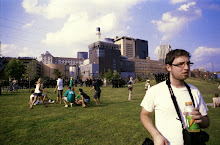Though this is not at all directly related to the impending New Orleans trip, it is still photojournalism related.
Yesterday, Nick and I ventured into St. Paul to record the events relating to the march and resulting protest. Cameras in hand, we followed reports of property damage and tear gas assaults throughout the city. Eventually, we got dug in with the Black Bloc and Indymedia to cover the protesting more effectively. We photographed other photographers and entire news crews being arrested. We also heard from other embedded photographers that the police officers were confiscating cameras, not just film, from photographers covering the event. All the while, we were wondering whether or not it was legal, or for that matter, ethical. Nick and I both felt that we were targeted because we had the capability to record the events. I should make it clear at this point that we weren't on either side of the dispute and neither of us took any part of the protest. I should also say that greater than 95% of the police officers we talked to were very respectful and courteous. Whenever we asked them about something, they didn't hesitate to give us clear, concise answers. When they closed off streets, they were more than happy to give us alternative routes around the city. They were also very receptive to the idea of documenting all parts of the protest. There were however, police officers that were extremely disrespectful and couldn't separate the idea of the protester from the idea of an observer or documentarian. These police officers judged us incessantly and gave us very generic labels, to our face, that we didn't feel was necessary.
It wasn't long before we were in the middle of yet another tear gas assault, this time involving National Guard troops with bean bag shotguns. Nick and I observed medical crews, not hired by the organizers, but by the protesters themselves, help those who were effected by the tear gas, dehydration, and wounds sustained from the bean bag shotguns. It was clear the police wanted this to be the "final showdown" as I'm sure they were dehydrated and tired, just like we were. More and more riot police emerged from the curtain of tear gas. The police informed us that if we dispersed in the opposite direction, we would be able to leave. Neither Nick nor I believed them as we had seen this happen before at other protests. Eventually, myself and everybody else remotely close by were surrounded. Protesters, observers, and concert-goers, alike. Then we were informed that we were under arrest. The cameras kept rolling and the photographers kept photographing. Nick and I were arrested and detained, but eventually let go after they found out we, along with about 90% of the other people they arrested and detained, had not actually commited a crime.
On our way out of St. Paul, we walked by the Xcel Energy Center and discovered how much they had beefed up security since the protests began. The Xcel was completely surrounded by a 10 foot tall fence and all entrances and exits were guarded by armed National Guardsmen and sturdy crash barriers. I thought this was particularly interesting to see. When I got home, I was disappointed to see some photographers had introduced their opinions, rather heavily, into their photos and introduced their own short-sighted commentary. I thought I would take some time to clarify a few things right now.
1. If you stick a camera in the face of any 16-20 year old person, without their permission, at a political rally, please do not act surprised when they give the middle finger, or any other "obscene gesture". This is not ground-breaking.
2. Not everybody wearing black is an anarchist. It will be very clear when you encounter one. If you still can't figure it out, they'll be the ones wearing black and red and traveling in a very large group.
3. Bandanas at a political rally are not for concealing identity. When soaked in vinegar, they are used to filter out tear gas in the air. Believe it or not, some poeple don't want to cough up their lungs for an hour when police decide to really let themselves go.
4. The numbers written on peoples' arms are not for their hot date later that evening, but for their lawyer. They're written down on their arm so big so you can still see them after you get blasted in the face with pepper spray and your cell phone gets confiscated.
5. None of the protesters are going to kill you. They won't even maim you. If you walk up to them and treat them with respect, they'll be extremely nice to you in return. Personally, if you're too scared to talk to them, then you shouldn't be at the rally. As they say: if you can't handle the heat, get out of the kitchen.
Those were just a few things that irritated me about the photographs that resulted from the protests. I suppose my griping originates from both Nick and I actually having a working knowledge of all the organizations that were present at the rally and actually talked to and interviewed many of the groups that had members arrested, then coming home to see people acting so foolishly about the whole situation. I believe that the situation was way overblown due to reporters and photographers having no idea what they're talking about. So when you read reports, take them with Dead Sea worth of salt.
Join Us This Summer
13 years ago




2 comments:
Let's see your pictures and hear the sounds you recorded...
Oh man, I wish I had some of the interviews to show you. I just got the field recorder this afternoon.
I will put up some pictures shortly, though.
Post a Comment